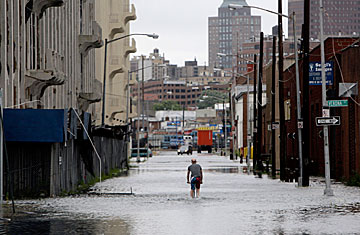
A man pedals through a flooded street in Brooklyn on Sunday, Aug. 28, 2011. Hurricane Irene's heavy rains caused some flooding, but all in all, New York City was spared the worst
As Hurricane Irene made its way up the East Coast, New York Governor Andrew Cuomo gave a speech on the Lower East Side of Manhattan. Flanked by some of the nearly 2,000 National Guardsmen he called up to help with what many were certain would be a major catastrophe, Cuomo urged people to take the storm seriously. "New Yorkers like to think we are tough," the governor said. "We are smart enough to know we don't mess with Mother Nature." But by the time the storm came ashore on Coney Island in Brooklyn at about 9 a.m. the next morning, it was clear that the worst fears for New York City would not be realized. The winds slowed, and heavy rains caused some flooding, but all in all, the city was spared the worst. But New Yorkers being New Yorkers, they seemed oddly let down by this fortuitous spin of the winds.
The morning after the storm, the best description of New Yorkers was "underwhelmed." After bracing for what many said might be the worst storm in a century, New Yorkers and their critics took to the social-media landscape to vent their frustrations. "BREAKING: Hurricane Irene Leaves New Yorkers Severely Disappointed," Dylan Stableford, a digital editor at Yahoo wrote on Twitter. Comedian Chris Grace was also not impressed, tweeting, "Irene downgraded to a tropical storm. Typical: you think you're hot shit, then you come to NYC and you're not as big a deal as you thought." Another New Yorker (and another comedian), Sara Benincasa, also commented on the perverse consternation that some New Yorkers seemed to be feeling that they weren't, after all, allowed to prove how tough they are. "Dear Rest of World," she tweeted, "Note that New Yorkers are fuming today that our city wasn't destroyed. Reconsider moving here."
Hurricane Irene may be remembered as the storm with which government leaders at many levels tried to right the sins of the past, even if that meant taking intense precautions for a storm that was less fierce than predicted. President Obama drew the correct political lessons from George W. Bush's failure to return from vacation when Hurricane Katrina struck the Gulf Coast in 2005. The Commander in Chief was back in Washington well in advance of Irene's landfall, coordinating with Homeland Security Secretary Janet Napolitano and other members of his Cabinet in the White House Situation Room. On Sunday, after the storm passed New York, FEMA released a report called Hurricane Irene: Overview of Federal Family's Preparations and Response. Note the bizarre inclusion of the word family where the word government should be. Government just isn't a popular word right now, even if the government is the one who will save you from your flooded home.
New York City Mayor Michael Bloomberg ordered the mandatory evacuation of more than 300,000 people from low-lying areas of the city, a move some in hindsight said was overkill. In preparing for Irene, Bloomberg seemed eager to avoid a repeat of his missteps during January's gargantuan blizzard that shut down parts of the city for days. Bloomberg was lambasted by even some of his closest allies for the city's performance during that snowstorm. In his first press conference after Irene, Bloomberg was asked if he had been too cautious in his preparations for the hurricane. "The best scenario possible is you take the precautions and it turns out they're not needed," Bloomberg said. "The exact opposite is not something you want to have happen."
As critics conduct the postmortem analysis on the first major hurricane to push into the Northeast in more than 20 years, it's clear that the media, both old and new, played a major role. Every major network had battalions of correspondents in brightly colored rain slickers stationed up and down the coast, reporting on the storm from the inside — literally in the water and battered by winds. While helpful in understanding the effects of the storm, some of the media coverage seemed ripe fodder for a Saturday Night Live sketch. On Saturday afternoon, a reporter for the Weather Channel, wearing swimming goggles to keep the water out of his eyes, dutifully described what anyone could see — that buckets of rain and high winds were enveloping coastal Carolina. But while he spoke, teenagers dressed in board shorts danced behind him.
